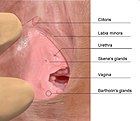Skene's ducts
| Skene's gland | |
|---|---|
 |
|
| Details | |
| Precursor | Urogenital sinus |
| Identifiers | |
| Latin | glandulae vestibulares minores |
| Dorlands /Elsevier |
Paraurethral glands |
| TA | A09.2.01.017 |
| FMA | 71648 |
|
Anatomical terminology
[]
|
|
In female human anatomy, Skene's glands or the Skene glands (/skiːn/ SKEEN; also known as the lesser vestibular glands, periurethral glands, paraurethral glands, or homologous female prostate) are glands located on the anterior wall of the vagina, around the lower end of the urethra. They drain into the urethra and near the urethral opening and may be near or a part of the G-spot. These glands are surrounded with tissue (which includes the part of the clitoris) that reaches up inside the vagina and swells with blood during sexual arousal.
The location of the Skene's glands are the general area of the vulva, located on the anterior wall of the vagina around the lower end of the urethra. The Skene's glands are homologous with the prostate gland in males, containing numerous microanatomical structures in common with the prostate gland, such as secretory cells. Skene's glands are not, however, explicit prostate glands themselves. By histological origin, the Skene's glands are often referred to as the homologue of the prostate. The two Skene's ducts lead from the Skene's glands to the surface of the vulva, to the left and right of the urethral opening from which they are structurally capable of secreting fluid. Although there remains debate about the function of the Skene's glands, one purpose is to secrete a fluid that helps lubricate the urethral opening, possibly contributing antimicrobial factors to protect the urinary tract from infections. Further, the Skene's glands secrete prostate-specific antigen (PSA), an ejaculate protein identically produced in males.
...
Wikipedia
